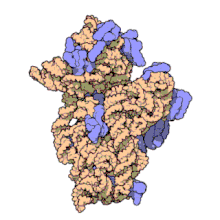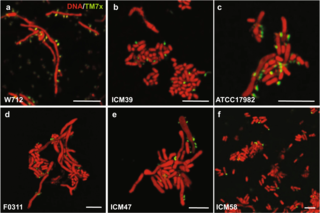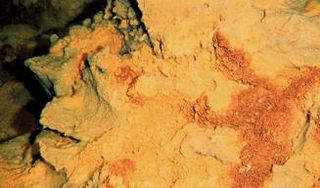| Phylum | Alternative names | Group | Cultured representative | Notes |
|---|
| 10bav-F6 [9] | | | No | |
| "Abawacabacteria" [4] [10] | RIF46 | CPR; Gracilibacteria-related CPR | No | |
| "Abditibacteriota" [11] | FBP | | Yes [11] | |
| "Absconditabacteria" [12] [10] | SR1 | CPR; Gracilibacteria-related CPR | No | |
| ABY1 [13] | OD1-ABY1 [14] | CPR; Parcubacteria | No | |
| "Bipolaricaulota" [15] | OP1, "Acetothermia" | | | |
| Acidobacteriota | "Acidobacteria" | | Yes [16] | |
| Actinomycetota | "Actinobacteria" | Terrabacteria | Yes [17] | |
| "Adlerbacteria" [18] [10] | | CPR; Patescibacteria; Parcubacteria; Parcubacteria 4 | No | |
| "Aerophobota" / "Aerophobetes" | CD12, BHI80-139 | | | |
| "Amesbacteria" [18] | | CPR; Patescibacteria; Microgenomates | No | |
| "Andersenbacteria" [4] | RIF9 | CPR; Parcubacteria; Parcubacteria 4-related | No | |
| Armatimonadota [15] | "Armatimonadetes", OP10 | Terrabacteria | Yes [19] | |
| "Aminicenantes" [15] | OP8 | | | |
| AncK6 [9] | | | | |
| Apal-E12 [9] | | | | |
| Atribacterota [15] | OP9, JS1 | | No | |
| Aquificota | "Aquificae" | | | |
| "Azambacteria" i [18] [10] | | CPR; Patescibacteria; Parcubacteria; unclassified Parcubacteria | No | split by Anantharaman et al. … |
| "Azambacteria" ii [18] [10] | | CPR; Patescibacteria; Parcubacteria; unclassified Parcubacteria | No | … (Oct 2016) as being polyphyletic |
| Bacteroidota | "Bacteroidetes" | FCB group | Yes | |
| Balneolota [20] | | | Yes | |
| Bdellovibrionota | | | | |
| "Beckwithbacteria" [18] | | CPR; Patescibacteria; Microgenomates | No | |
| "Berkelbacteria" [21] [10] | ACD58 | CPR; Saccharibacteria-related CPR | No | |
| BHI80-139 [9] | | | | |
| "Blackburnbacteria" [4] | RIF35 | CPR; Microgenomates | No | |
| "Brennerbacteria" [4] [10] | RIF18 | CPR; Parcubacteria; Parcubacteria 3 | No | |
| "Brownbacteria" [22] | | CPR; Parcubacteria; unclassified Parcubacteria | No | |
| "Buchananbacteria" [4] [10] | RIF37 | CPR; Parcubacteria; Parcubacteria 1 | No | |
| Caldisericota [15] | OP5, [23] "Caldiserica" | FCB group | Yes [24] | |
| Calditrichota [25] | | FCB group [26] | | |
| "Calescamantes" | EM19 | | | |
| "Campbellbacteria" [18] [10] | | CPR; Patescibacteria; Parcubacteria; Parcubacteria 4 | No | seem to be polyphyletic: two clades |
| Campylobacterota | | | | |
| Chlamydiota | "Chlamydiae" [27] | PVC group | | |
| Chlorobiota | "Chlorobi" | FCB group | | |
| Chloroflexota | "Chloroflexi" | "Terrabacteria" | | |
| Chisholmbacteria [4] | RIF36 | CPR; "Microgenomates" | No | |
| Chrysiogenota | "Chrysiogenetes" | | | |
| "Cloacimonetes" [28] | WWE1 | FCB group [26] | | |
| "Coatesbacteria" [4] | RIF8 | | No | |
| "Collierbacteria" [18] | | CPR; Patescibacteria; Microgenomates | No | |
| "Colwellbacteria" [4] [10] | RIF41 | CPR; Parcubacteria; Parcubacteria 3 | No | |
| Coprothermobacterota | | | | |
| "Curtissbacteria" [18] | | CPR; Patescibacteria; Microgenomates | No | |
| CPR-1 [1] | | CPR | No | |
| CPR-3 [1] | | CPR | No | |
| "Cyanobacteria" | | Terrabacteria | | |
| "Dadabacteria" [29] | | | No | |
| "Daviesbacteria" [18] | | CPR; Patescibacteria; Microgenomates | No | |
| "Delphibacteria" [6] | | FCB group | No | |
| "Delongbacteria" [4] | RIF26, H-178 | | No | |
| Deferribacterota | Deferribacteres | | | |
| Deinococcota | Deinococcus–Thermus | Terrabacteria | | |
| "Dependentiae" [30] | TM6 | | | |
| Dictyoglomota | Dictyoglomi [31] | | | |
| "Dojkabacteria" [10] | WS6 | CPR; Microgenomates-related CPR | | |
| "Dormibacteraeota" [32] | AD3 | | No | |
| "Doudnabacteria" [18] [10] | SM2F11 | CPR; Parcubacteria; Parcubacteria 1-related | No | |
| "Edwardsbacteria" [5] [4] | RIF29, UBP-2 [33] | | No | |
| "Eisenbacteria" [4] | RIF28 | FCB group | No | |
| Elusimicrobiota | Elusimicrobia, OP7, Termite Group 1 (TG1) [23] | | Yes [34] | |
| "Eremiobacteraeota" [35] [32] | WPS-2, Palusbacterota [36] | | No | |
| "Falkowbacteria" [18] [10] | | CPR; Patescibacteria; Parcubacteria; Parcubacteria 1 | No | |
| "Fermentibacteria" [37] | Hyd24-12 | | No | |
| "Fertabacteria" [6] | | CPR; Gracilibacteria-related CPR | No | |
| Fibrobacterota | "Fibrobacteres" | FCB group | | |
| "Firestonebacteria" [4] | RIF1 | | No | |
| "Fervidibacteria" | OctSpa1-106 | | | |
| "Fischerbacteria" [4] | RIF25 | | No | |
| Bacillota | "Firmicutes" | Terrabacteria | | |
| "Fraserbacteria" [4] | RIF31 | | No | |
| Fusobacteriota | "Fusobacteria" | | | |
| Gemmatimonadota | Gemmatimonadetes [38] | FCB group [26] | Yes [38] | |
| "Glassbacteria" [4] | RIF5 | | No | |
| "Giovannonibacteria" [18] [10] | | CPR; Patescibacteria; Parcubacteria; Parcubacteria 4-related | No | |
| "Gottesmanbacteria" [18] | | CPR; Patescibacteria; Microgenomates | No | |
| "Gracilibacteria" [39] [10] | GN02, BD1-5, SN-2 | CPR; Patescibacteria; Gracilibacteria-related CPR | No | |
| "Gribaldobacteria" [4] [10] | | CPR; Parcubacteria; Parcubacteria 2 | No | |
| "Handelsmanbacteria" [4] | RIF27 | | No | |
| "Harrisonbacteria" [4] [10] | RIF43 | CPR; Parcubacteria; Parcubacteria 3 | No | |
| "Howlettbacteria" [10] | | CPR; Saccharibacteria-related CPR | No | |
| "Hugbacteria" [22] | | CPR; Parcubacteria; unclassified Parcubacteria | No | |
| "Hydrogenedentes" | NKB19 | | No | |
| Ignavibacteriota | "Ignavibacteria", ZB1 | FCB group | | |
| "Jacksonbacteria" [4] [10] | RIF38 | CPR; Parcubacteria; Parcubacteria 1 | No | |
| "Jorgensenbacteria" [18] [10] | | CPR; Patescibacteria; Parcubacteria; Parcubacteria 3 | No | |
| "Kaiserbacteria" [18] [10] | | CPR; Patescibacteria; Parcubacteria; Parcubacteria 4 | No | |
| "Katanobacteria" [40] [10] | WWE3 | CPR; Microgenomates-related | No | |
| "Kazanbacteria" [10] [4] | Kazan | CPR; Saccharibacteria-related CPR | No | |
| "Kerfeldbacteria" [4] [10] | RIF4 | CPR; Parcubacteria; Parcubacteria 1 | No | |
| Kiritimatiellota | | | | |
| "Komeilibacteria" [4] [10] | RIF6 | CPR; Parcubacteria; Parcubacteria 1 | No | sometimes misspelled as "Komelilbacteria" [4] |
| "Kryptonia" [41] | | | No | |
| KSB1 | | | No | |
| "Krumholzibacteriota" [33] | | | | |
| "Kuenenbacteria" [18] [10] | | CPR; Patescibacteria; Parcubacteria; Parcubacteria 1 | No | |
| "Lambdaproteobacteria" [4] | RIF24 | Proteobacteria | No | |
| "Latescibacteria" | WS3 | FCB group [26] | No | |
| LCP-89 [42] | | | | |
| Lentisphaerota | "Lentisphaerae", vadinBE97 | PVC group | | |
| "Levybacteria" [18] | | CPR; Patescibacteria; Microgenomates | No | |
| "Lindowbacteria" [4] | RIF2 | CPR; Saccharibacteria-related CPR | No | |
| "Liptonbacteria" [4] [10] | RIF42 | CPR; Parcubacteria; Parcubacteria 3 | No | |
| "Lloydbacteria" [4] [10] | RIF45 | CPR; Parcubacteria; Parcubacteria 4 | No | |
| "Magasanikbacteria" [18] [43] [10] | | CPR; Patescibacteria; Parcubacteria; Parcubacteria 1 | No | |
| "Margulisbacteria" [4] | RIF30 | | No | |
| "Marinimicrobia" | SAR406, Marine Group A | FCB group [26] | Yes | |
| "Melainabacteria" [44] | | | No | |
| "Microgenomates" [45] | OP11 | CPR; Patescibacteria | No | Superphylum |
| "Modulibacteria" [39] [46] | KSB3, GN06 | | No | |
| "Moranbacteria" [18] [10] | OD1-i [18] | CPR; Patescibacteria; Parcubacteria; unclassified Parcubacteria | No | |
| "Muproteobacteria" [4] | RIF23 | Proteobacteria | No | |
| Myxococcota | | | | |
| NC10 [47] [13] | | | No | |
| "Nealsonbacteria" [4] [10] | RIF40 | CPR; Parcubacteria; Parcubacteria 2 | No | |
| "Niyogibacteria" [4] | RIF11 | CPR; Parcubacteria; Parcubacteria 4-related | No | |
| Nitrospinota | "Nitrospinae" [48] | | Yes [49] [50] | |
| Nitrospirota | "Nitrospirae" | | Yes | |
| "Nomurabacteria" [18] [10] | | CPR; Patescibacteria; Parcubacteria; Parcubacteria 1 | No | |
| "Omnitrophica" [15] | OP3 | PVC group | No | |
| "Pacebacteria" [18] | | CPR; Patescibacteria; Microgenomates | No | |
| "Parcubacteria" [12] | OD1 | CPR | No | Superphylum |
| "Parcubacteria" 1 [10] | | CPR; Parcubacteria | No | |
| "Parcubacteria" 2 [10] | | CPR; Parcubacteria | No | |
| "Parcubacteria" 3 [10] | | CPR; Parcubacteria | No | |
| "Parcubacteria" 4 [10] | | CPR; Parcubacteria | No | |
| "Parcunitrobacteria" [51] | | CPR; Parcubacteria; unclassified Parcubacteria [52] | No | Superphylum |
| PAUC34f [53] | sponge‐associated unclassified lineage (SAUL) | FCB group | | |
| "Peregrinibacteria" [54] [55] [56] [57] [10] | PER | CPR; Gracilibacteria-related CPR | No | |
| "Peribacteria" [10] | | CPR; Gracilibacteria-related CPR | No | |
| Planctomycetota | "Planctomycetes" | PVC group | | |
| "Poribacteria" [58] | | PVC group | | |
| "Portnoybacteria" [4] | RIF22 | CPR; Parcubacteria; Parcubacteria 4-related | No | |
| Pseudomonadota | "Proteobacteria" | | | |
| "Raymondbacteria" [4] | RIF7 | | No | |
| Riflebacteria [4] | RIF32 | | No | |
| Rhodothermota | | | | |
| "Roizmanbacteria" [18] | | CPR; Patescibacteria; Microgenomates | No | |
| "Rokubacteria" [29] | | | No | |
| "Ryanbacteria" [4] [10] | RIF10 | CPR; Parcubacteria; Parcubacteri 4-related | No | |
| "Saccharibacteria" [30] [10] | TM7 | CPR; Saccharibacteria-related CPR | Yes | |
| "Saltatorellota" [59] | | | | |
| "Schekmanbacteria" [4] | RIF3 | Proteobacteria | No | |
| "Shapirobacteria" [18] | | CPR; Patescibacteria; Microgenomates | No | |
| "Spechtbacteria" [4] [10] | RIF19 | CPR; Parcubacteria; Parcubacteria 2 | No | |
| Spirochaetota | "Spirochaetes" | | | |
| "Staskawiczbacteria" [4] [10] | RIF20 | CPR; Parcubacteria; Parcubacteria 2 | No | |
| "Sumerlaeota" [60] [61] | BRC1 | | | |
| "Sungbacteria" [4] [10] | RIF17 | CPR; Parcubacteria; Parcubacteria 4-related | No | |
| Synergistota | "Synergistetes" | | | |
| TA06 [62] | | | No | |
| "Tagabacteria" [4] [10] | RIF12 | CPR; Parcubacteria; Parcubacteria 4-related | No | |
| "Taylorbacteria" [4] [10] | RIF16 | CPR; Parcubacteria; Parcubacteria 4 | No | |
| "Tectomicrobia" [63] | | | | |
| Mycoplasmatota | "Tenericutes" | | | |
| "Terrybacteria" [4] [10] | RIF13 | CPR; Parcubacteria; Parcubacteria 2 | No | |
| Thermodesulfobacteriota | "Thermodesulfobacteria" | | | |
| Thermomicrobiota | "Thermomicrobia" | | | |
| Thermotogota | "Thermotogae", OP2, EM3 [23] | | Yes [64] | |
| "Torokbacteria" [10] | | CPR; Parcubacteria; unclssified Parcubacteria | No | |
| UBP-1 [5] | | | No | |
| UBP-3 [5] | | | No | |
| UBP-4 [5] | | | No | |
| UBP-5 [5] | | | No | |
| UBP-6 [5] | | | No | |
| UBP-7 [5] | | | No | |
| UBP-8 [5] | | | No | |
| UBP-9 [5] | | | No | |
| UBP-10 [5] | | | No | |
| UBP-11 [5] | | | No | |
| UBP-12 [5] | | | No | |
| UBP-13 [5] | | | No | |
| UBP-14 [5] | | | No | |
| UBP-15 [5] | | | No | |
| UBP-16 [5] | | | No | |
| UBP-17 [5] | | | No | |
| "Uhrbacteria" [18] [10] | | CPR; Patescibacteria; Parcubacteria; Parcubacteria 1 | No | seem to be polyphyletic: two clades |
| "Veblenbacteria" [4] | RIF39 | CPR; Parcubacteria; Parcubacteria 1-related | No | |
| Verrucomicrobiota | "Verrucomicrobia" | PVC group | | |
| "Vogelbacteria" [4] [10] | RIF14 | CPR; Parcubacteria; Parcubacteria 4 | No | |
| "Wallbacteria" [4] | RIF33 | | No | |
| "Wildermuthbacteria" [4] [10] | RIF21 | CPR; Parcubacteria; Parcubacteria 2 | No | |
| "Wirthbacteria" [65] | | CPR-related bacteria | No | |
| "Woesebacteria" [18] | | CPR; Patescibacteria; Microgenomates | No | |
| "Wolfebacteria" [18] [10] | | CPR; Patescibacteria; Parcubacteria; Parcubacteria 3 | No | |
| "Woykebacteria" [4] [22] | RIF34 | CPR; Microgenomates | No | |
| WOR-1 [62] | | | No | |
| WOR-2 [62] | | | No | |
| WOR-3 [62] | | | No | |
| "Yanofskybacteria" [18] [10] | | CPR; Patescibacteria; Parcubacteria; unclassified Parcubacteria | No | |
| "Yonathbacteria" [4] [10] | RIF44 | CPR; Parcubacteria; Parcubacteria 4 | No | |
| "Zambryskibacteria" [4] [10] | RIF15 | CPR; Parcubacteria; Parcubacteria 4 | No | |
| ZB2 | OD1-ZB2 [14] | CPR; Parcubacteria | No | |
| "Zixibacteria" [66] | | FCB group | No | |










